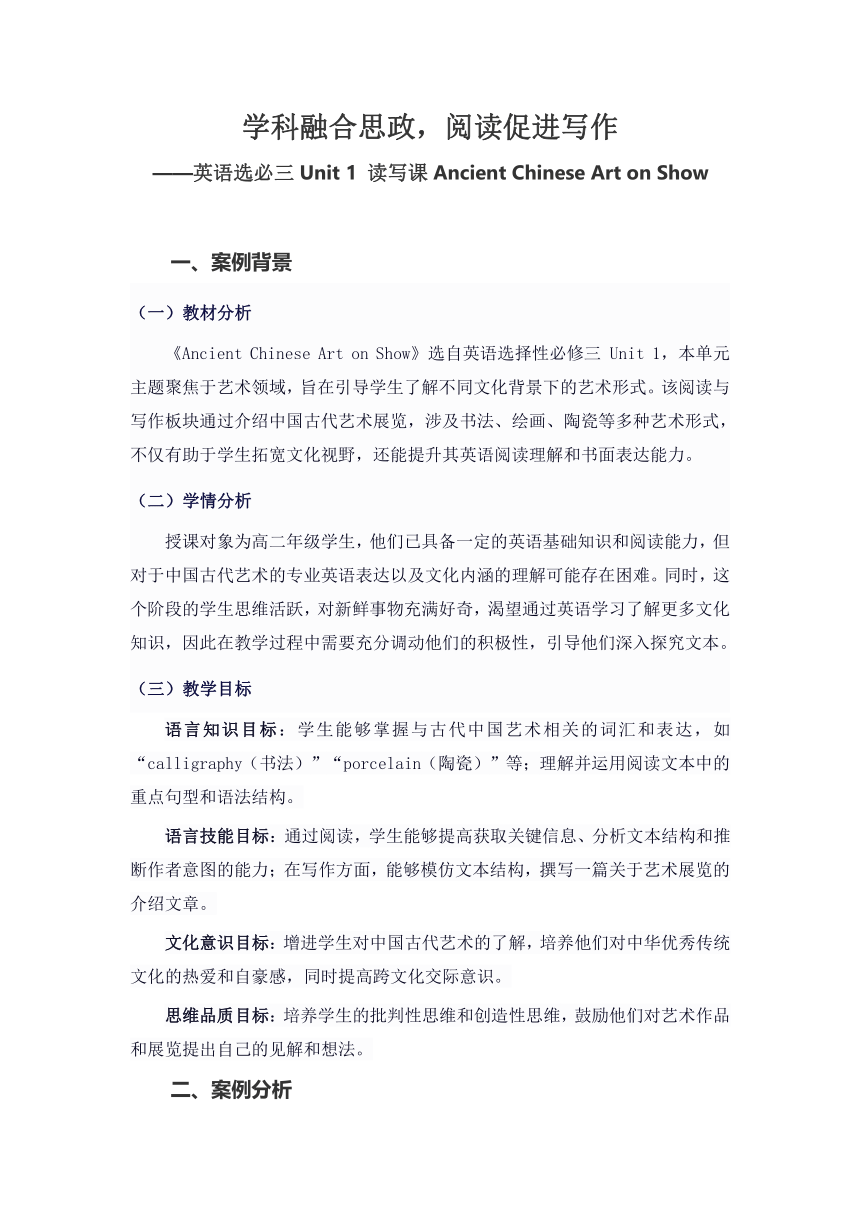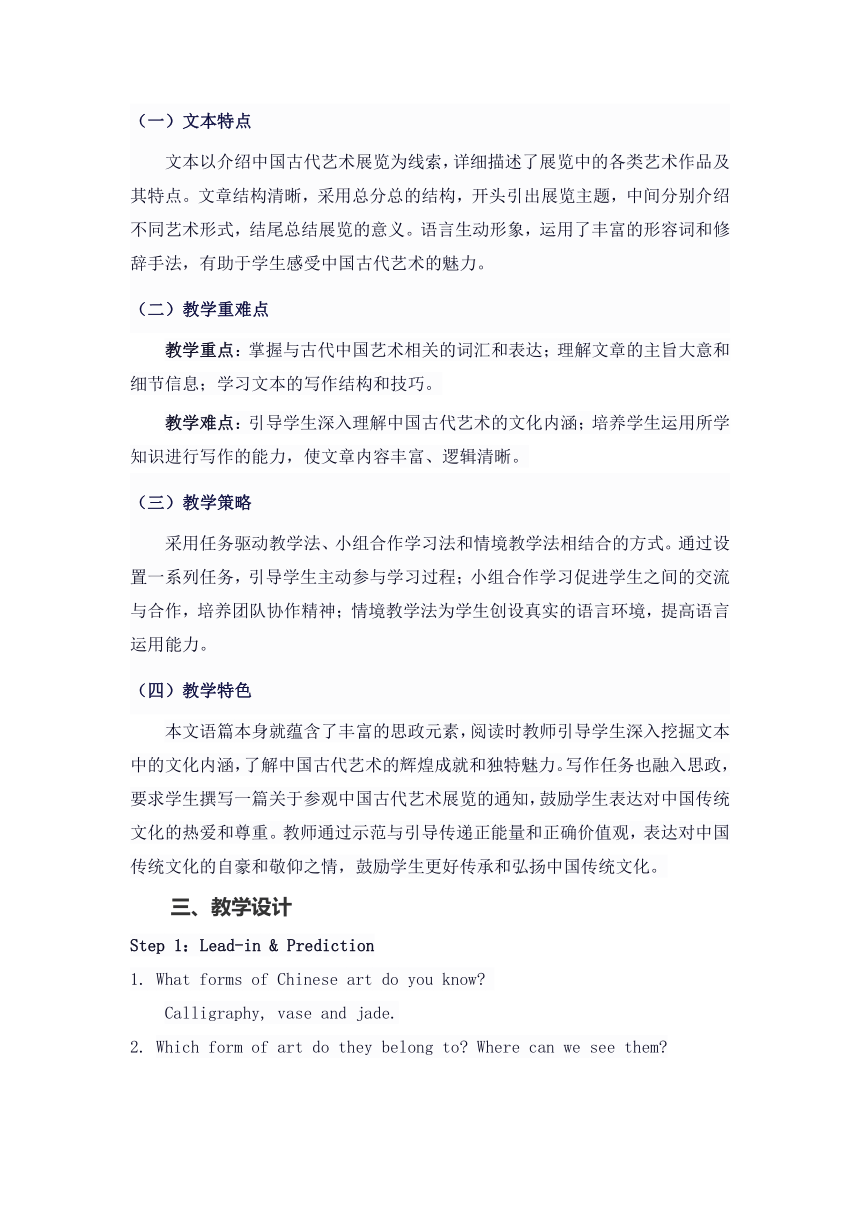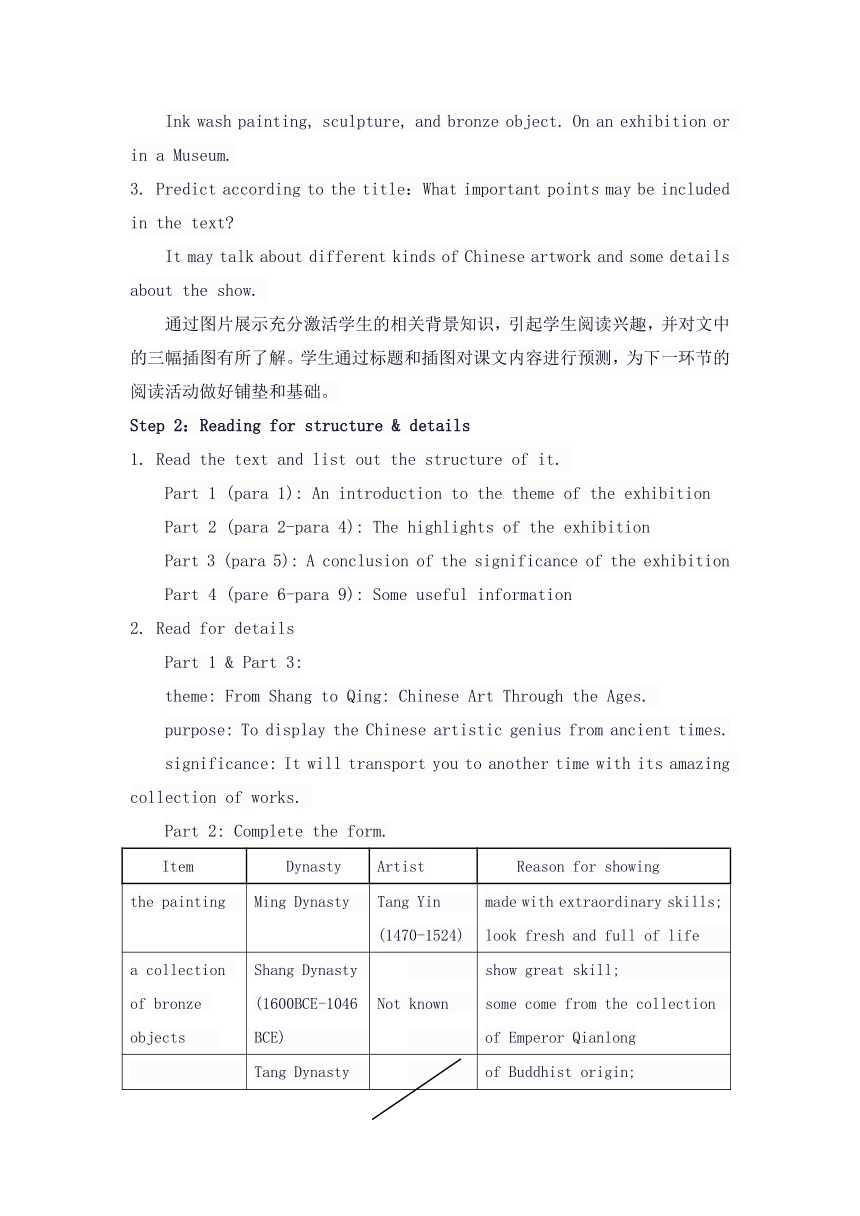人教版(2019)选择性必修第三册 Unit 1 Art 读写课教案
文档属性
| 名称 | 人教版(2019)选择性必修第三册 Unit 1 Art 读写课教案 |  | |
| 格式 | docx | ||
| 文件大小 | 187.6KB | ||
| 资源类型 | 教案 | ||
| 版本资源 | 人教版(2019) | ||
| 科目 | 英语 | ||
| 更新时间 | 2025-08-23 23:53:01 | ||
图片预览



文档简介
学科融合思政,阅读促进写作
——英语选必三Unit 1 读写课Ancient Chinese Art on Show
案例背景
(一)教材分析
《Ancient Chinese Art on Show》选自英语选择性必修三 Unit 1,本单元主题聚焦于艺术领域,旨在引导学生了解不同文化背景下的艺术形式。该阅读与写作板块通过介绍中国古代艺术展览,涉及书法、绘画、陶瓷等多种艺术形式,不仅有助于学生拓宽文化视野,还能提升其英语阅读理解和书面表达能力。
(二)学情分析
授课对象为高二年级学生,他们已具备一定的英语基础知识和阅读能力,但对于中国古代艺术的专业英语表达以及文化内涵的理解可能存在困难。同时,这个阶段的学生思维活跃,对新鲜事物充满好奇,渴望通过英语学习了解更多文化知识,因此在教学过程中需要充分调动他们的积极性,引导他们深入探究文本。
(三)教学目标
语言知识目标:学生能够掌握与古代中国艺术相关的词汇和表达,如“calligraphy(书法)”“porcelain(陶瓷)”等;理解并运用阅读文本中的重点句型和语法结构。
语言技能目标:通过阅读,学生能够提高获取关键信息、分析文本结构和推断作者意图的能力;在写作方面,能够模仿文本结构,撰写一篇关于艺术展览的介绍文章。
文化意识目标:增进学生对中国古代艺术的了解,培养他们对中华优秀传统文化的热爱和自豪感,同时提高跨文化交际意识。
思维品质目标:培养学生的批判性思维和创造性思维,鼓励他们对艺术作品和展览提出自己的见解和想法。
案例分析
(一)文本特点
文本以介绍中国古代艺术展览为线索,详细描述了展览中的各类艺术作品及其特点。文章结构清晰,采用总分总的结构,开头引出展览主题,中间分别介绍不同艺术形式,结尾总结展览的意义。语言生动形象,运用了丰富的形容词和修辞手法,有助于学生感受中国古代艺术的魅力。
(二)教学重难点
教学重点:掌握与古代中国艺术相关的词汇和表达;理解文章的主旨大意和细节信息;学习文本的写作结构和技巧。
教学难点:引导学生深入理解中国古代艺术的文化内涵;培养学生运用所学知识进行写作的能力,使文章内容丰富、逻辑清晰。
(三)教学策略
采用任务驱动教学法、小组合作学习法和情境教学法相结合的方式。通过设置一系列任务,引导学生主动参与学习过程;小组合作学习促进学生之间的交流与合作,培养团队协作精神;情境教学法为学生创设真实的语言环境,提高语言运用能力。
(四)教学特色
本文语篇本身就蕴含了丰富的思政元素,阅读时教师引导学生深入挖掘文本中的文化内涵,了解中国古代艺术的辉煌成就和独特魅力。写作任务也融入思政,要求学生撰写一篇关于参观中国古代艺术展览的通知,鼓励学生表达对中国传统文化的热爱和尊重。教师通过示范与引导传递正能量和正确价值观,表达对中国传统文化的自豪和敬仰之情,鼓励学生更好传承和弘扬中国传统文化。
教学设计
Step 1:Lead-in & Prediction
1. What forms of Chinese art do you know
Calligraphy, vase and jade.
Which form of art do they belong to Where can we see them
Ink wash painting, sculpture, and bronze object. On an exhibition or in a Museum.
Predict according to the title:What important points may be included in the text
It may talk about different kinds of Chinese artwork and some details about the show.
通过图片展示充分激活学生的相关背景知识,引起学生阅读兴趣,并对文中的三幅插图有所了解。学生通过标题和插图对课文内容进行预测,为下一环节的阅读活动做好铺垫和基础。
Step 2:Reading for structure & details
Read the text and list out the structure of it.
Part 1 (para 1): An introduction to the theme of the exhibition
Part 2 (para 2-para 4): The highlights of the exhibition
Part 3 (para 5): A conclusion of the significance of the exhibition
Part 4 (pare 6-para 9): Some useful information
Read for details
Part 1 & Part 3:
theme: From Shang to Qing: Chinese Art Through the Ages.
purpose: To display the Chinese artistic genius from ancient times.
significance: It will transport you to another time with its amazing collection of works.
Part 2: Complete the form.
Item Dynasty Artist Reason for showing
the painting Ming Dynasty Tang Yin (1470-1524) made with extraordinary skills; look fresh and full of life
a collection of bronze objects Shang Dynasty (1600BCE-1046BCE) Not known show great skill; some come from the collection of Emperor Qianlong
the sculptures Tang Dynasty (618-907) of Buddhist origin; of exceptional beauty and quality; bring history to life
Part 4: What kind of information does part 4 include
It gives some useful information in details, including the date, the opening hours, the ticket prices and the rules or requirements.
3. Complete the advertising leaflet according to the text.
学生通过快速阅读对文章的篇章结构进行划分和梳理,并总结出每个部分的主要内容,掌握主题展览推介文的文体结构。通过阅读梳理三种艺术品的相关有用信息,明确文章的目标人群,写作意图和文本类型,同时找出关键信息完成展览宣传页,对课文内容有了更深刻的理解。
Step 3:Comparison & Appreciation
1.What are the differences between an announcement and an advertising leaflet
Type of writing Features of Language Features of Structure
Announcement attractive details; appealing descriptions Introduction Highlights Conclusion Useful information
Advertising leaflet more concise; simple phrases of key points to make it clear Title Sub-title key information
2. Learn the useful expressions
So how to make an announcement attractive and appealing Please find out and learn the useful expressions and sentence patterns in the text.
The highlight of this exhibition is …
In time, he gained recognition as one of the greatest artists China has ever known.
This painting, showing …, was made with extraordinary skill.
While the artists who made these great works are not known, they showed great skill in creating these beautiful pieces.
It didn’t really begin to show expansion until…
Chinese sculpture thus found itself highly influenced by …
They are of exceptional beauty and quality.
History is brought to life.
This is just a small taste of what is in store for you in this exhibition. We guarantee that……
No photos or food and drink are allowed in the museum.
学生通过对比分析,明确主题展览推介文和展览宣传页两种应用文体的文体结构和语言特征。学生找出并学习文中的优美表达和有用句型,尤其是关于刻画艺术品细节的宣传句式,进行有效的语言输入,为写作环节打下扎实的基础。
Step 4:Writing an announcement
You are now going to write an announcement for art club members about a trip to see an exhibition.
1. Brainstorm the details about the exhibition and take notes.
What is the exhibition about
What are the highlights
When are you going
Where shall you meet
How are you going to get there
What should you bring
2. Write your announcement based on your notes.
To: the City Museum
From: the school gate at 8:30 a.m. next Sunday by bus
Subject: “Amazing Chinese Paintings”
Highlights: some ink wash paintings by Qi Baishi
3. Pay attention to the structure and language of the announcement.
Brief introduction: theme/ purpose/ location
Highlights and significance
Useful information: opening time/ requirements
4. Use the checklist to check your own writing.
Is the announcement clear and to the point
Is the language attractive and appealing
Is all the necessary information about the exhibition included
Do you use correct grammar, punctuation, and spelling
学生通过头脑风暴列出公告的要点,并根据笔记和所学内容完成一则主题展览公告,在真实情景中进行仿写,运用所学句型表达,学以致用。完成以后,学生对照评价标准进行自评,找出不足之处。最后,通过学习范文,进一步理解公告的写作要点和有效表达。
案例成效
(一)学生学习效果
通过本节课的学习,学生掌握了一系列与古代中国艺术相关的词汇和表达,能够熟练运用重点句型进行交流和写作。在后续的课堂练习和作业中,学生对相关词汇和语法的运用准确率明显提高。学生的阅读理解能力得到提升,能够快速准确地获取文章的关键信息,分析文本结构和作者意图的能力也有所增强。在写作方面,学生能够模仿文本结构,撰写出内容较为丰富、逻辑清晰的文章,语言表达更加流畅。学生对中国古代艺术有了更深入的了解,增强了对中华优秀传统文化的认同感和自豪感。在写作过程中,学生能够提出自己独特的观点,对艺术作品和展览进行深入分析,批判性思维和创造性思维得到了锻炼。可见,学生在语言知识、语言技能、文化意识和思维品质方面都有所收获。
(二)教师教学经验
通过本节课的教学实践,发现任务驱动教学法能够充分调动学生的学习积极性,提高课堂参与度。在阅读教学环节,要充分发挥学生的自主能动性,积极参与课堂活动。在写作教学环节,需要给予学生更多的时间和指导,帮助他们提高写作能力。
五、案例反思
本堂课的教学重难点是学生通过阅读文章,了解艺术展览推介文的特点,并学会写一则主题展览公告,同时掌握主题展览推介文和展览宣传页两种应用文体的文体结构和语言特征。课后可以鼓励学生通过互联网搜索、博物馆实地考查等多种途径寻找更多的艺术展览公告或者宣传手册,进一步了解主题展览公告的特点和写作技巧,进一步树立文化意识,增强文化自信。
在教学设计中,教师紧密围绕中国古代艺术展览这一主题,选取了弘扬传统文化、增强文化自信等思政元素。这些元素与单元教学内容高度契合,能自然地融入到词汇讲解、文本分析、写作任务等教学环节中,让学生在学习英语知识的同时,深刻感受中国古代艺术的魅力与价值,明白传承和弘扬优秀传统文化的意义。
在课堂教学中,阅读环节教师引导学生深入挖掘文本中关于中国古代艺术成就的描述,组织学生讨论其对现代文化发展的启示,强化了学生对传统文化的认同感。写作环节教师鼓励学生表达参观古代艺术展览后的感受,以及对传承传统文化的思考,促使学生将思政认知转化为实际行动意愿。
总体来说,本堂课体现了课程思政与学科内容的高度融合,二者有机结合,相得益彰,实现了语言能力提升与思政教育的同步推进。
——英语选必三Unit 1 读写课Ancient Chinese Art on Show
案例背景
(一)教材分析
《Ancient Chinese Art on Show》选自英语选择性必修三 Unit 1,本单元主题聚焦于艺术领域,旨在引导学生了解不同文化背景下的艺术形式。该阅读与写作板块通过介绍中国古代艺术展览,涉及书法、绘画、陶瓷等多种艺术形式,不仅有助于学生拓宽文化视野,还能提升其英语阅读理解和书面表达能力。
(二)学情分析
授课对象为高二年级学生,他们已具备一定的英语基础知识和阅读能力,但对于中国古代艺术的专业英语表达以及文化内涵的理解可能存在困难。同时,这个阶段的学生思维活跃,对新鲜事物充满好奇,渴望通过英语学习了解更多文化知识,因此在教学过程中需要充分调动他们的积极性,引导他们深入探究文本。
(三)教学目标
语言知识目标:学生能够掌握与古代中国艺术相关的词汇和表达,如“calligraphy(书法)”“porcelain(陶瓷)”等;理解并运用阅读文本中的重点句型和语法结构。
语言技能目标:通过阅读,学生能够提高获取关键信息、分析文本结构和推断作者意图的能力;在写作方面,能够模仿文本结构,撰写一篇关于艺术展览的介绍文章。
文化意识目标:增进学生对中国古代艺术的了解,培养他们对中华优秀传统文化的热爱和自豪感,同时提高跨文化交际意识。
思维品质目标:培养学生的批判性思维和创造性思维,鼓励他们对艺术作品和展览提出自己的见解和想法。
案例分析
(一)文本特点
文本以介绍中国古代艺术展览为线索,详细描述了展览中的各类艺术作品及其特点。文章结构清晰,采用总分总的结构,开头引出展览主题,中间分别介绍不同艺术形式,结尾总结展览的意义。语言生动形象,运用了丰富的形容词和修辞手法,有助于学生感受中国古代艺术的魅力。
(二)教学重难点
教学重点:掌握与古代中国艺术相关的词汇和表达;理解文章的主旨大意和细节信息;学习文本的写作结构和技巧。
教学难点:引导学生深入理解中国古代艺术的文化内涵;培养学生运用所学知识进行写作的能力,使文章内容丰富、逻辑清晰。
(三)教学策略
采用任务驱动教学法、小组合作学习法和情境教学法相结合的方式。通过设置一系列任务,引导学生主动参与学习过程;小组合作学习促进学生之间的交流与合作,培养团队协作精神;情境教学法为学生创设真实的语言环境,提高语言运用能力。
(四)教学特色
本文语篇本身就蕴含了丰富的思政元素,阅读时教师引导学生深入挖掘文本中的文化内涵,了解中国古代艺术的辉煌成就和独特魅力。写作任务也融入思政,要求学生撰写一篇关于参观中国古代艺术展览的通知,鼓励学生表达对中国传统文化的热爱和尊重。教师通过示范与引导传递正能量和正确价值观,表达对中国传统文化的自豪和敬仰之情,鼓励学生更好传承和弘扬中国传统文化。
教学设计
Step 1:Lead-in & Prediction
1. What forms of Chinese art do you know
Calligraphy, vase and jade.
Which form of art do they belong to Where can we see them
Ink wash painting, sculpture, and bronze object. On an exhibition or in a Museum.
Predict according to the title:What important points may be included in the text
It may talk about different kinds of Chinese artwork and some details about the show.
通过图片展示充分激活学生的相关背景知识,引起学生阅读兴趣,并对文中的三幅插图有所了解。学生通过标题和插图对课文内容进行预测,为下一环节的阅读活动做好铺垫和基础。
Step 2:Reading for structure & details
Read the text and list out the structure of it.
Part 1 (para 1): An introduction to the theme of the exhibition
Part 2 (para 2-para 4): The highlights of the exhibition
Part 3 (para 5): A conclusion of the significance of the exhibition
Part 4 (pare 6-para 9): Some useful information
Read for details
Part 1 & Part 3:
theme: From Shang to Qing: Chinese Art Through the Ages.
purpose: To display the Chinese artistic genius from ancient times.
significance: It will transport you to another time with its amazing collection of works.
Part 2: Complete the form.
Item Dynasty Artist Reason for showing
the painting Ming Dynasty Tang Yin (1470-1524) made with extraordinary skills; look fresh and full of life
a collection of bronze objects Shang Dynasty (1600BCE-1046BCE) Not known show great skill; some come from the collection of Emperor Qianlong
the sculptures Tang Dynasty (618-907) of Buddhist origin; of exceptional beauty and quality; bring history to life
Part 4: What kind of information does part 4 include
It gives some useful information in details, including the date, the opening hours, the ticket prices and the rules or requirements.
3. Complete the advertising leaflet according to the text.
学生通过快速阅读对文章的篇章结构进行划分和梳理,并总结出每个部分的主要内容,掌握主题展览推介文的文体结构。通过阅读梳理三种艺术品的相关有用信息,明确文章的目标人群,写作意图和文本类型,同时找出关键信息完成展览宣传页,对课文内容有了更深刻的理解。
Step 3:Comparison & Appreciation
1.What are the differences between an announcement and an advertising leaflet
Type of writing Features of Language Features of Structure
Announcement attractive details; appealing descriptions Introduction Highlights Conclusion Useful information
Advertising leaflet more concise; simple phrases of key points to make it clear Title Sub-title key information
2. Learn the useful expressions
So how to make an announcement attractive and appealing Please find out and learn the useful expressions and sentence patterns in the text.
The highlight of this exhibition is …
In time, he gained recognition as one of the greatest artists China has ever known.
This painting, showing …, was made with extraordinary skill.
While the artists who made these great works are not known, they showed great skill in creating these beautiful pieces.
It didn’t really begin to show expansion until…
Chinese sculpture thus found itself highly influenced by …
They are of exceptional beauty and quality.
History is brought to life.
This is just a small taste of what is in store for you in this exhibition. We guarantee that……
No photos or food and drink are allowed in the museum.
学生通过对比分析,明确主题展览推介文和展览宣传页两种应用文体的文体结构和语言特征。学生找出并学习文中的优美表达和有用句型,尤其是关于刻画艺术品细节的宣传句式,进行有效的语言输入,为写作环节打下扎实的基础。
Step 4:Writing an announcement
You are now going to write an announcement for art club members about a trip to see an exhibition.
1. Brainstorm the details about the exhibition and take notes.
What is the exhibition about
What are the highlights
When are you going
Where shall you meet
How are you going to get there
What should you bring
2. Write your announcement based on your notes.
To: the City Museum
From: the school gate at 8:30 a.m. next Sunday by bus
Subject: “Amazing Chinese Paintings”
Highlights: some ink wash paintings by Qi Baishi
3. Pay attention to the structure and language of the announcement.
Brief introduction: theme/ purpose/ location
Highlights and significance
Useful information: opening time/ requirements
4. Use the checklist to check your own writing.
Is the announcement clear and to the point
Is the language attractive and appealing
Is all the necessary information about the exhibition included
Do you use correct grammar, punctuation, and spelling
学生通过头脑风暴列出公告的要点,并根据笔记和所学内容完成一则主题展览公告,在真实情景中进行仿写,运用所学句型表达,学以致用。完成以后,学生对照评价标准进行自评,找出不足之处。最后,通过学习范文,进一步理解公告的写作要点和有效表达。
案例成效
(一)学生学习效果
通过本节课的学习,学生掌握了一系列与古代中国艺术相关的词汇和表达,能够熟练运用重点句型进行交流和写作。在后续的课堂练习和作业中,学生对相关词汇和语法的运用准确率明显提高。学生的阅读理解能力得到提升,能够快速准确地获取文章的关键信息,分析文本结构和作者意图的能力也有所增强。在写作方面,学生能够模仿文本结构,撰写出内容较为丰富、逻辑清晰的文章,语言表达更加流畅。学生对中国古代艺术有了更深入的了解,增强了对中华优秀传统文化的认同感和自豪感。在写作过程中,学生能够提出自己独特的观点,对艺术作品和展览进行深入分析,批判性思维和创造性思维得到了锻炼。可见,学生在语言知识、语言技能、文化意识和思维品质方面都有所收获。
(二)教师教学经验
通过本节课的教学实践,发现任务驱动教学法能够充分调动学生的学习积极性,提高课堂参与度。在阅读教学环节,要充分发挥学生的自主能动性,积极参与课堂活动。在写作教学环节,需要给予学生更多的时间和指导,帮助他们提高写作能力。
五、案例反思
本堂课的教学重难点是学生通过阅读文章,了解艺术展览推介文的特点,并学会写一则主题展览公告,同时掌握主题展览推介文和展览宣传页两种应用文体的文体结构和语言特征。课后可以鼓励学生通过互联网搜索、博物馆实地考查等多种途径寻找更多的艺术展览公告或者宣传手册,进一步了解主题展览公告的特点和写作技巧,进一步树立文化意识,增强文化自信。
在教学设计中,教师紧密围绕中国古代艺术展览这一主题,选取了弘扬传统文化、增强文化自信等思政元素。这些元素与单元教学内容高度契合,能自然地融入到词汇讲解、文本分析、写作任务等教学环节中,让学生在学习英语知识的同时,深刻感受中国古代艺术的魅力与价值,明白传承和弘扬优秀传统文化的意义。
在课堂教学中,阅读环节教师引导学生深入挖掘文本中关于中国古代艺术成就的描述,组织学生讨论其对现代文化发展的启示,强化了学生对传统文化的认同感。写作环节教师鼓励学生表达参观古代艺术展览后的感受,以及对传承传统文化的思考,促使学生将思政认知转化为实际行动意愿。
总体来说,本堂课体现了课程思政与学科内容的高度融合,二者有机结合,相得益彰,实现了语言能力提升与思政教育的同步推进。
